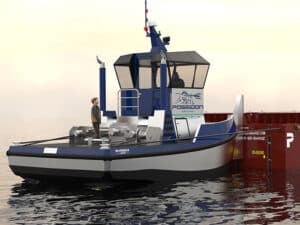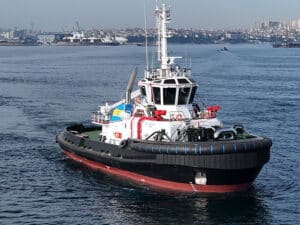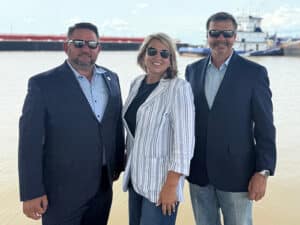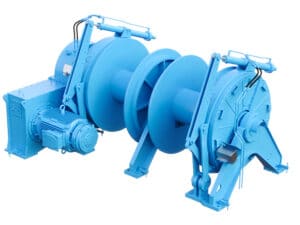
Is the U.S. ready to adopt new technology for tugs and towboats?
Written by Heather Ervin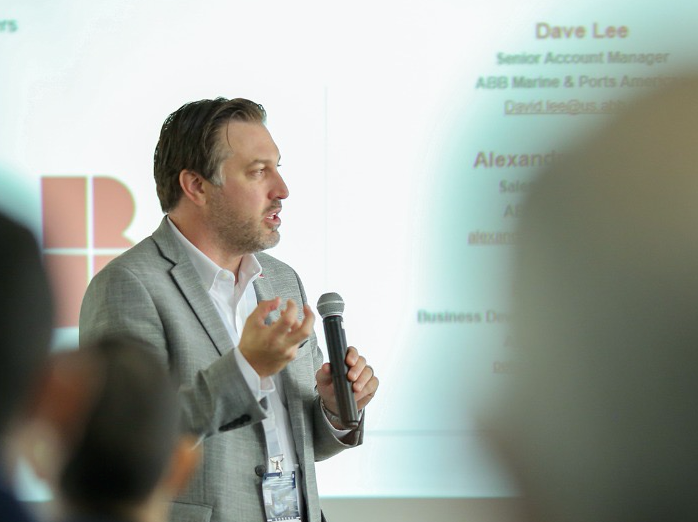
David Lee, ABB Marine & Ports
A Q&A with Dave Lee, Senior Account Manager – ABB Marine & Ports
Marine Log (ML): The world’s first LNG-hybrid tug is being built in Singapore. How long before we start seeing hybrid tugs here in the U.S.?
Dave Lee (DL): The idea of hybrid tugs has been around for some time, with Foss Maritime adopting batteries over a decade ago. Then ABB saw a pause in the push for advanced vessels until 2019.
It is now apparent that the next generation of newbuild advanced propulsion tugs in the U.S. has officially started. In 2019, tugs were built with small electric motors to still assist the main engines for part of the propulsion, but the power for the electric motors still come from diesel generators, so they are diesel electric assisted in the design sense.
This is the most common first step that we have seen around the world as owners are cautious about how much new technology they want to adopt. The downside to a cautious approach is that the owners are pretty much tied to the main diesel engines for the life of the tug.
The upgrade to electric is still possible, but it is not an easy upgrade. This is compared to operators who built their tug with an electric motor as the main propulsion. In doing so, they have future-proofed their tug as different power sources will quickly come to the market in the next 30 years.
The current time we are in has slowed newbuilds around the world. I have operators contacting me all the time when considering hybrid tugs in any newbuild program as oil majors and ports are applying pressure to reduce the carbon footprint. So, as the U.S. climbs out of the pandemic over the next year or so, I strongly feel that we will see operators looking past systems that rely on diesel engines and look for more advanced power systems that will allow them to be prepared for years to come.
ML: Last year, a PTO/PTI tug came out and is being adapted differently around the world. Can you explain what this tug is and how it could eventually be adapted for the U.S. market?
DL: South Asia’s first LNG hybrid tug utilizes LNG main engines along with smaller electric motors to assist the main engines, such as the systems I discussed prior. The added twist is two-fold in this tug compared to what we have seen in the U.S. thus far.
First, the tug will utilize LNG engines, which is a step forward to reduce emissions compared to a diesel engine. Second, the tug will utilize a battery system as a true hybrid assist. LNG engines are typically slow to respond compared to high-speed diesel engines, so the batteries will be utilized to respond to the high dynamic demands a tug sees during operation.
One item to point out is that in South Asia, there is a reliable source of LNG in the port. This is not something that is available broadly in the U.S. I do see tug operators having interest in this style of hybrid tug but only as the LNG availability increases throughout ports. With LNG availability being limited or nonexistent from one port to another, operators can’t move tugs around from port to port as they do today. With any new fuel, if the infrastructure is developed then the operators will gain more interest.
ML: We’ve been talking about tugs, but what about towboats? Are there any new technologies being put into use now on towing vessels? If not, will there be soon?
DL: I am always happy to discuss towboats, as I am a product of the inland towboat world, where I spent almost a decade in the inland market. My experience has made me very aware of the drivers in this market.
There is a lot of competition in the inland market, thus there is a lot of pressure on equipment cost and the amount of operational risk that an operator wants to take (a towboat must reliably leave and show up on time or another operator could sneak into an operator’s business). With these factors in mind, the towboat world is slow to adopt to new technology in the U.S. Throughout the rest of the world, towboat operators are adopting new technology.
In Brazil, I start the conversation with diesel electric propulsion systems for inland operators that operate on the Amazon River system. Diesel electric is the common propulsion system throughout Brazilian river systems. As another example, in France, ABB is part of a team that will have the first inland towboat with hydrogen fuel cells for propulsion power this year.
With other parts of the world adopting advanced propulsion systems, along with some of the same pressures (customer and regulatory) that the tug market is seeing, towboat operators are gaining more interest. We are seeing operational savings on all the towboats that have been built with advanced systems (maintenance, fuel, urea, etc.) and as U.S. operators realize these savings, they are gaining even more interest.
I would like to say we will have a diesel electric or hybrid on the water soon, but the inland world is feeling another time of low demand. Boat builds are currently very slow because of this down time; however, as boat builds start again, I know diesel electric systems will be part of the conversation with operators.
ML: Anything else ABB would like to comment on in terms of tug and towboat technology we should keep our eyes peeled for in 2021?
DL: At ABB, we are always looking to the next step in the marine world. Diesel electric and hybrid systems are already being adopted around the world and ABB Marine & Ports was one of the pioneers in this market. I tell everyone to just look at what is happening around us as we are in our cars driving down the road.
This is the future for the marine industry; however, the marine world is a decade behind the technology we see on the road. With that in mind, we are seeing more and more electric cars on the roads as well as the development of the infrastructure to adapt to customers’ needs. We will see tugs and towboats start to move to these systems as the benefits can’t be ignored.
The other item that we see taking off in the transportation market is autonomous and semi-autonomous operations. At ABB Marine & Ports, we are part of a project in collaboration with Singaporean shipyard Keppel Offshore & Marine to convert an existing tug to have the capability of fully autonomous operations this year.
As operators continue to see pressure on insurance rates as well as pressure from customers (tug and towboat operators see requirements to report incident rates), they will see the benefit from systems that make the captain’s job easier and safer every day. I would definitely keep my eyes open to identify where these digital systems are going and where they are adopted in the marine industry.

